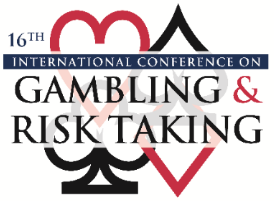Session Title
Session 2-1-A: Assessing Problem Gambling Vulnerabilities through Research
Presentation Type
Event
Location
The Mirage Hotel & Casino, Las Vegas, Nevada
Start Date
8-6-2016 8:30 AM
End Date
8-6-2016 10:00 AM
Disciplines
Clinical Psychology | Cognitive Psychology | Mental Disorders | Psychology | Statistics and Probability
Abstract
Gambling Disorder is the first behavioural addiction to be recognised in the substance-related and addictive disorders chapter of the DSM-V. However, unlike Substance Use Disorders, craving has not been added as a criterion for diagnosis for Gambling Disorder. This may be, in part, due to the conflicting findings of investigations into the neural basis of cue reactivity in the disorder, with evidence for both hypo-activity (Potenza et al. 2003 Arch Gen Psychiatry) and hyper-reactivity (e.g. Goudriaan et al 2010 Add Biol). The present functional MRI studies sought to quantify brain responses of patients with Gambling Disorder to gambling-related images, and to investigate if these craving-related responses were modulated by the opioid antagonist naltrexone. We recruited treatment-seeking gamblers (N=19, median age = 31) and a healthy control group (N=19, median age = 28). Participants viewed blocks of gambling-related images and matched neutral images. Craving ratings indicated the cues were effective at inducing a craving state, with patients with Gambling Disorder showing increased craving to gamble after gambling cues compared to non-gambling cues (F(1.25,45.01)=21.15, p
Keywords
craving, fmri, gambling, cue reactivity
Streaming Media
Neural substrates of cue reactivity and craving in Gambling Disorder
The Mirage Hotel & Casino, Las Vegas, Nevada
Gambling Disorder is the first behavioural addiction to be recognised in the substance-related and addictive disorders chapter of the DSM-V. However, unlike Substance Use Disorders, craving has not been added as a criterion for diagnosis for Gambling Disorder. This may be, in part, due to the conflicting findings of investigations into the neural basis of cue reactivity in the disorder, with evidence for both hypo-activity (Potenza et al. 2003 Arch Gen Psychiatry) and hyper-reactivity (e.g. Goudriaan et al 2010 Add Biol). The present functional MRI studies sought to quantify brain responses of patients with Gambling Disorder to gambling-related images, and to investigate if these craving-related responses were modulated by the opioid antagonist naltrexone. We recruited treatment-seeking gamblers (N=19, median age = 31) and a healthy control group (N=19, median age = 28). Participants viewed blocks of gambling-related images and matched neutral images. Craving ratings indicated the cues were effective at inducing a craving state, with patients with Gambling Disorder showing increased craving to gamble after gambling cues compared to non-gambling cues (F(1.25,45.01)=21.15, p


Comments
Audio recording of this presentation is attached as a downloadable MP3 audio file, 48.5 MB